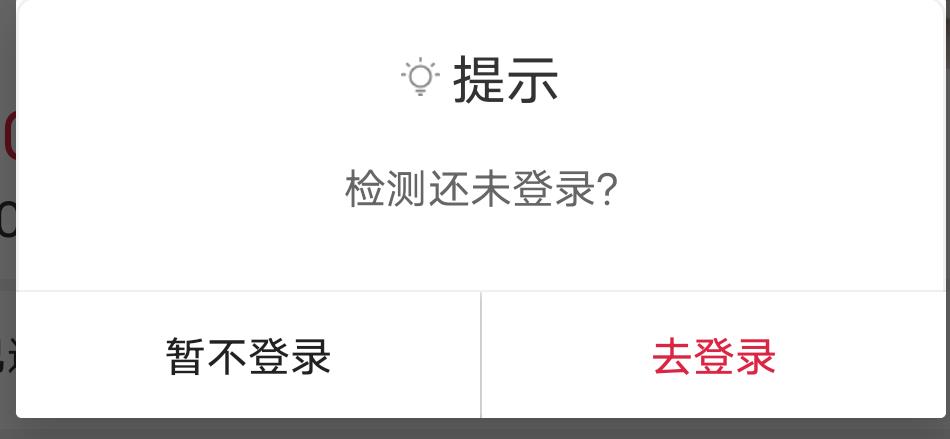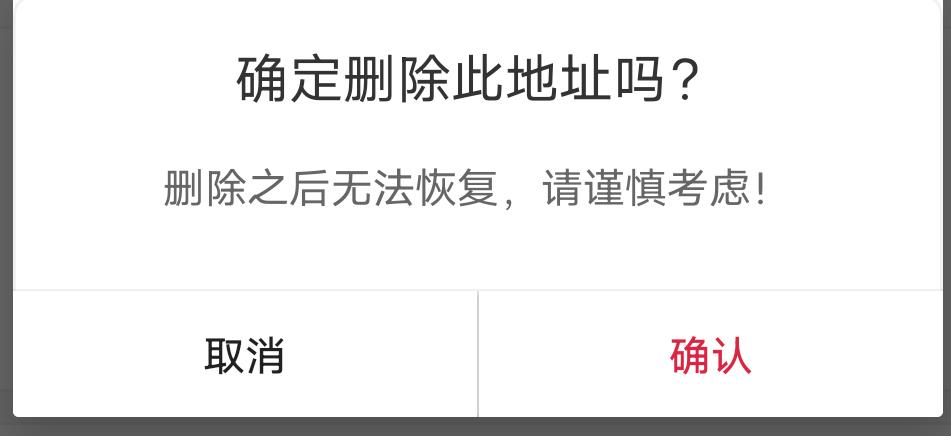Android应用中如何自定义弹框?
Posted kaolagirl
tags:
篇首语:本文由小常识网(cha138.com)小编为大家整理,主要介绍了Android应用中如何自定义弹框?相关的知识,希望对你有一定的参考价值。
在我们应用开发过程中,系统自带的弹框效果不是很好看,所以我们就得自己去自定义,下面就来简单说说吧
1.效果

2.自定义弹框布局(alert_dialog_defaut.xml)
<LinearLayout xmlns:android="http://schemas.android.com/apk/res/android"
android:layout_width="match_parent"
android:layout_height="wrap_content"
android:orientation="vertical">
<LinearLayout
android:orientation="vertical"
android:layout_width="match_parent"
android:layout_height="wrap_content"
android:background="@drawable/content_corner">
<LinearLayout
android:gravity="center"
android:layout_marginTop="15dp"
android:orientation="horizontal"
android:layout_width="match_parent"
android:layout_height="wrap_content">
<ImageView
android:id="@+id/iv_dialog_tip"
android:visibility="gone"
android:layout_marginRight="4dp"
android:layout_gravity="center"
android:src="@drawable/dialog_tip"
android:layout_width="13dp"
android:layout_height="13dp"/>
<TextView
android:id="@+id/title"
android:text="标题"
android:gravity="center"
android:textColor="@color/theme_defaultText"
android:textSize="@dimen/larMax_size"
android:layout_width="wrap_content"
android:layout_height="wrap_content"/>
</LinearLayout>
<TextView
android:id="@+id/content"
android:layout_margin="15dp"
android:gravity="center"
android:text="内容"
android:textSize="@dimen/order1"
android:lineHeight="20dp"
android:textColor="@color/theme_textColor"
android:layout_width="match_parent"
android:layout_height="wrap_content"/>
<TextView
android:layout_marginTop="10dp"
android:background="@color/banner_backColor"
android:layout_width="match_parent"
android:layout_height="0.8dp"/>
<LinearLayout
android:layout_width="match_parent"
android:layout_height="wrap_content">
<Button
android:id="@+id/cancel_btn"
android:background="@color/white"
android:textSize="@dimen/order1"
android:text="取消"
android:layout_weight="1.0"
android:layout_width="wrap_content"
android:layout_height="42dp"/>
<TextView
android:background="@color/banner_backColor"
android:layout_width="0.5dp"
android:layout_height="match_parent"/>
<Button
android:id="@+id/comfirm_btn"
android:background="@color/white"
android:text="确认"
android:textSize="@dimen/order1"
android:textColor="@color/theme_color"
android:layout_weight="1.0"
android:layout_width="wrap_content"
android:layout_height="42dp"/>
</LinearLayout>
</LinearLayout>
</LinearLayout>
2.自定义一个弹框工具类(AlertDialogUtils.java)
// 自定义dialog对话框
public class AlertDialogUtils {
private static View view_custom;
public static AlertDialog.Builder builder;
public static AlertDialog alert ;
public static TextView tv_dialog_title, tv_dialog_content;
public static Button dialog_cancelBtn,dialog_confirmBtn;
public static AlertDialogUtils getInstance() {
return new AlertDialogUtils();
}
/**
* todo 带有确认取消按钮的自定义dialog
* @param context 上下文对象
* @param title 标题
* @param content 内容
*/
public static void showConfirmDialog(Context context, String title, String content){
builder = new AlertDialog.Builder(context);
alert = builder.create();
alert.show();
//引入布局
view_custom =LayoutInflater.from(context).inflate(R.layout.alert_dialog_defaut,null,false);
tv_dialog_title = view_custom.findViewById(R.id.title);
tv_dialog_title.setText(title);
tv_dialog_content = view_custom.findViewById(R.id.content);
tv_dialog_content.setText(content);
alert.setCancelable(false); //点击空白处不关闭弹窗
//为取消按钮设置点击监听
view_custom.findViewById(R.id.cancel_btn).setOnClickListener(new View.OnClickListener() {
@Override
public void onClick(View v) {
if(mOnDialogButtonClickListener !=null){
mOnDialogButtonClickListener.onNegativeButtonClick(alert);
}
}
});
//为确认按钮设置点击监听
view_custom.findViewById(R.id.comfirm_btn).setOnClickListener(new View.OnClickListener() {
@Override
public void onClick(View v) {
if(mOnDialogButtonClickListener !=null){
mOnDialogButtonClickListener.onPositiveButtonClick(alert);
}
}
});
//使用布局
alert.getWindow().setContentView(view_custom);
}
//todo 按钮点击回调接口
public static OnDialogButtonClickListener mOnDialogButtonClickListener;
public void setMonDialogButtonClickListener(OnDialogButtonClickListener listener){
this.mOnDialogButtonClickListener = listener;
}
public interface OnDialogButtonClickListener{
void onPositiveButtonClick(AlertDialog dialog); //确认
void onNegativeButtonClick(AlertDialog dialog); //取消
}
}
3.在activity/Fragment中使用
使用工具类方便,就是哪里用到直接调用就可以了,而不用每次需要时都要重新引入布局,创建一大堆
AlertDialogUtils dialogUtils =AlertDialogUtils.getInstance();
AlertDialogUtils.showConfirmDialog(GoodAddress.this,"确定删除此地址吗?","删除之后无法恢复,请谨慎考虑!");
dialogUtils.setMonDialogButtonClickListener(new AlertDialogUtils.OnDialogButtonClickListener() {
@Override
public void onPositiveButtonClick(androidx.appcompat.app.AlertDialog dialog) {
//点击确认按钮要做的事情
}
@Override
public void onNegativeButtonClick(androidx.appcompat.app.AlertDialog dialog) {
//点击取消按钮关闭弹框
dialog.dismiss();
}
});
这样子就已经完成啦!!!!!最后,附上效果图

以上是关于Android应用中如何自定义弹框?的主要内容,如果未能解决你的问题,请参考以下文章